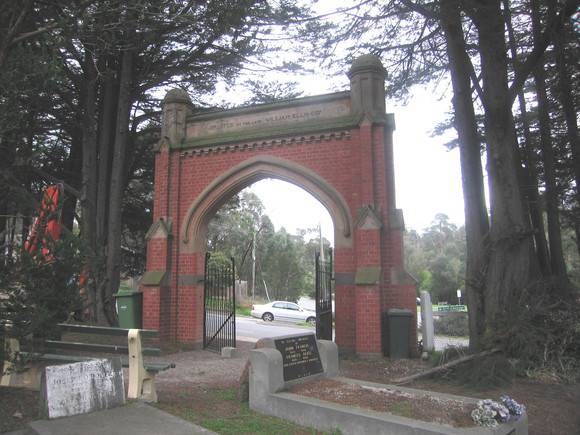| Back to search results » | Back to search page » |
|
Nillumbik Cemetery
Location35 Main Street,, DIAMOND CREEK VIC 3089 - Property No B4781
File NumberB4781LevelRegional |
|
Statement of Significance
What is significant? Nillumbik Cemetery occupies an area of two acres between Main and Edinburgh Streets. It is positioned on high ground above Sawpit Creek and the Diamond Creek floodplain.
The small cemetery was laid out in grid formation with a main north-south drive and graves mostly along a north-south alignment. The cemetery is entered through an impressive brick and rendered archway, built 1897 and a white timber picket hand gate on Main Street. Thereis a hexagonal timber office and amodern hexagonal shelter.
Surrounding the cemetery on the north (Main Street) and west sides is a Cupressus macrocarpa (Monterey Cypress) row, formerly a hedge. There is a fine Cupressus sempervirens (Italian Cypress), and Cupressus sempervirens 'Stricta', two English Hawthorn, Melealeuca armillaris row (x13) along part of the east side.Also later plantings of native trees and shrubs, a few roses, bulbs, oxalis, periwinkle, ivy and a rosemary plant.
How is it significant? The Nillumbik Cemetery is of historical, architectural, aesthetic and social significance at a Regional level (North-east Melbourne). The memorial arch is of State significance.
Why is it significant? Nillumbik Cemetery, which was established in 1867, is of historical and social significance for its association with the early history of Diamond Creek and as a record of the pioneering families of the district.
Significant graves include those of the famous writer Alan Marshall, author of 'I Can Jump Puddles', footballer Gordon Coventry, and William Ellis, notable early settler and benefactor. The 1897 Tudor/Gothic revival memorial arch, bequeathed by William Ellis, is a rare design in ornamental gateways and is relatively large for the size of the cemetery. It is unique in Victoria as a cemetery gateway arch. The burial ground has associated structures, such as the hexagonal timber sexton's office, post and wire fence and picket hand gate along Main Street, all probably built in the early twentieth century.
The cemetery also has significant plantings: pines that date to the foundation and laying out of the cemetery in the late 1860s and a boundary cypress row that dates to the 1920s.
Classified: 22/10/2007
File Note.Within the cemetery, the Ellis Arch is classified as State.
Group
Cemeteries and Burial Sites
Category
Cemetery Gates/Fences




